选择最佳工具,几何形状和切削条件
成形磨齿机的切削参数分析与优化
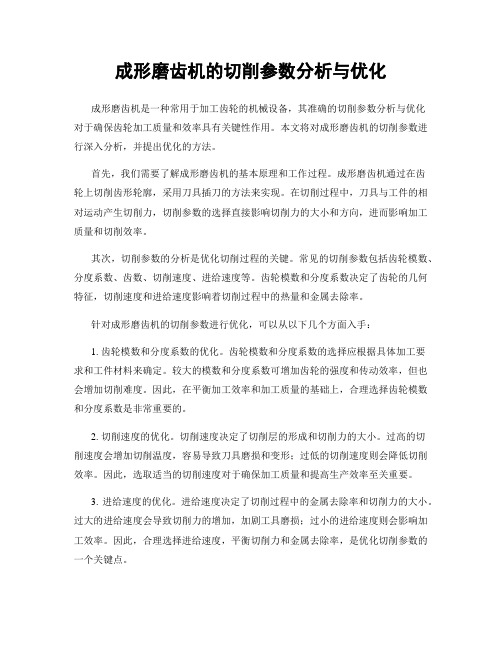
成形磨齿机的切削参数分析与优化成形磨齿机是一种常用于加工齿轮的机械设备,其准确的切削参数分析与优化对于确保齿轮加工质量和效率具有关键性作用。
本文将对成形磨齿机的切削参数进行深入分析,并提出优化的方法。
首先,我们需要了解成形磨齿机的基本原理和工作过程。
成形磨齿机通过在齿轮上切削齿形轮廓,采用刀具插刀的方法来实现。
在切削过程中,刀具与工件的相对运动产生切削力,切削参数的选择直接影响切削力的大小和方向,进而影响加工质量和切削效率。
其次,切削参数的分析是优化切削过程的关键。
常见的切削参数包括齿轮模数、分度系数、齿数、切削速度、进给速度等。
齿轮模数和分度系数决定了齿轮的几何特征,切削速度和进给速度影响着切削过程中的热量和金属去除率。
针对成形磨齿机的切削参数进行优化,可以从以下几个方面入手:1. 齿轮模数和分度系数的优化。
齿轮模数和分度系数的选择应根据具体加工要求和工件材料来确定。
较大的模数和分度系数可增加齿轮的强度和传动效率,但也会增加切削难度。
因此,在平衡加工效率和加工质量的基础上,合理选择齿轮模数和分度系数是非常重要的。
2. 切削速度的优化。
切削速度决定了切削层的形成和切削力的大小。
过高的切削速度会增加切削温度,容易导致刀具磨损和变形;过低的切削速度则会降低切削效率。
因此,选取适当的切削速度对于确保加工质量和提高生产效率至关重要。
3. 进给速度的优化。
进给速度决定了切削过程中的金属去除率和切削力的大小。
过大的进给速度会导致切削力的增加,加剧工具磨损;过小的进给速度则会影响加工效率。
因此,合理选择进给速度,平衡切削力和金属去除率,是优化切削参数的一个关键点。
除了以上三个方面,还需要考虑切削润滑条件、刀具的选择和工件夹紧等因素。
合适的切削润滑条件可以减小切削力,提高刀具寿命;正确选择刀具材料、几何形状和涂层可以增加切削效率和加工质量;有效的工件夹紧方式可以减少变形和振动,提高切削稳定性。
为了进一步优化成形磨齿机的切削参数,可以借助模拟和仿真技术进行虚拟实验。
刀具几何形状参数对切削力的影响分析
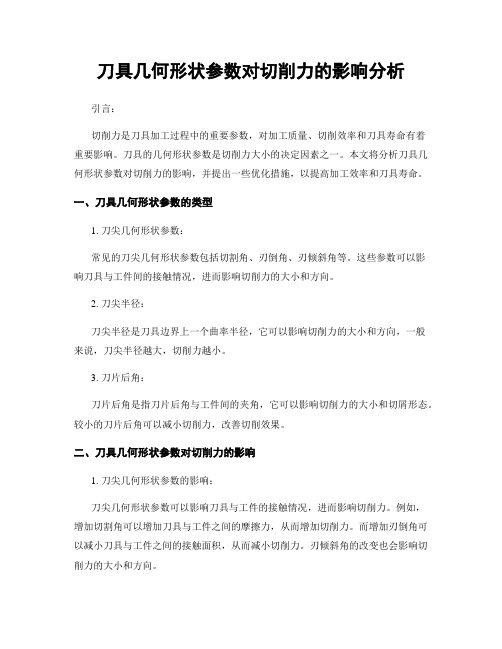
刀具几何形状参数对切削力的影响分析引言:切削力是刀具加工过程中的重要参数,对加工质量、切削效率和刀具寿命有着重要影响。
刀具的几何形状参数是切削力大小的决定因素之一。
本文将分析刀具几何形状参数对切削力的影响,并提出一些优化措施,以提高加工效率和刀具寿命。
一、刀具几何形状参数的类型1. 刀尖几何形状参数:常见的刀尖几何形状参数包括切割角、刃倒角、刃倾斜角等。
这些参数可以影响刀具与工件间的接触情况,进而影响切削力的大小和方向。
2. 刀尖半径:刀尖半径是刀具边界上一个曲率半径,它可以影响切削力的大小和方向,一般来说,刀尖半径越大,切削力越小。
3. 刀片后角:刀片后角是指刀片后角与工件间的夹角,它可以影响切削力的大小和切屑形态。
较小的刀片后角可以减小切削力,改善切削效果。
二、刀具几何形状参数对切削力的影响1. 刀尖几何形状参数的影响:刀尖几何形状参数可以影响刀具与工件的接触情况,进而影响切削力。
例如,增加切割角可以增加刀具与工件之间的摩擦力,从而增加切削力。
而增加刃倒角可以减小刀具与工件之间的接触面积,从而减小切削力。
刃倾斜角的改变也会影响切削力的大小和方向。
2. 刀尖半径对切削力的影响:刀尖半径主要影响了刀具接触压力的分布。
较大的刀尖半径可以减小切削区域的压力,从而减小切削力。
然而,过大的刀尖半径可能导致刀具易于磨损,减少工具使用寿命。
3. 刀片后角对切削力的影响:刀片后角的改变可以影响切削力的大小,但也会对切削质量产生影响。
在一定范围内,较小的刀片后角会减小切削力,并提升切削质量;然而,过小的刀片后角可能导致切削力不稳定和切削质量下降。
三、刀具几何形状参数的优化方法1. 刀尖几何形状参数的优化:选择合适的切割角、刃倒角和刃倾斜角,可以在保证切削力不过大的前提下,提高切削效果和工具寿命。
优化刀尖几何形状参数的方法包括结构设计与材料选择等。
2. 刀尖半径的优化:根据具体加工要求,选择适当的刀尖半径,以平衡切削力与刀具寿命之间的关系。
机械加工工艺工程师岗位面试题及答案(经典版)
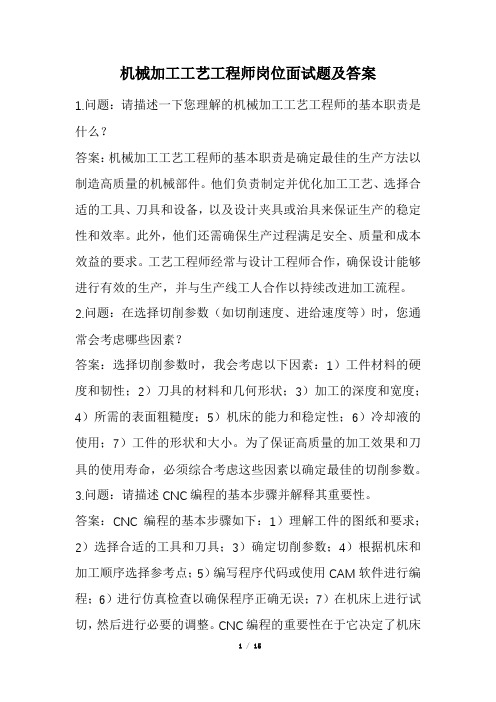
机械加工工艺工程师岗位面试题及答案1.问题:请描述一下您理解的机械加工工艺工程师的基本职责是什么?答案:机械加工工艺工程师的基本职责是确定最佳的生产方法以制造高质量的机械部件。
他们负责制定并优化加工工艺、选择合适的工具、刀具和设备,以及设计夹具或治具来保证生产的稳定性和效率。
此外,他们还需确保生产过程满足安全、质量和成本效益的要求。
工艺工程师经常与设计工程师合作,确保设计能够进行有效的生产,并与生产线工人合作以持续改进加工流程。
2.问题:在选择切削参数(如切削速度、进给速度等)时,您通常会考虑哪些因素?答案:选择切削参数时,我会考虑以下因素:1)工件材料的硬度和韧性;2)刀具的材料和几何形状;3)加工的深度和宽度;4)所需的表面粗糙度;5)机床的能力和稳定性;6)冷却液的使用;7)工件的形状和大小。
为了保证高质量的加工效果和刀具的使用寿命,必须综合考虑这些因素以确定最佳的切削参数。
3.问题:请描述CNC编程的基本步骤并解释其重要性。
答案:CNC编程的基本步骤如下:1)理解工件的图纸和要求;2)选择合适的工具和刀具;3)确定切削参数;4)根据机床和加工顺序选择参考点;5)编写程序代码或使用CAM软件进行编程;6)进行仿真检查以确保程序正确无误;7)在机床上进行试切,然后进行必要的调整。
CNC编程的重要性在于它决定了机床的运动轨迹和加工效果。
正确的编程能够确保高效、准确和安全的生产。
4.问题:如何评估刀具的磨损,并决定更换的时机?答案:评估刀具磨损的方法包括:1)直接观察,查找刀尖的缺损或磨损;2)监听加工过程中的噪音,判断是否有异常;3)检查加工表面的质量;4)测量切削力或振动来评估刀具状态;5)根据刀具的使用时间或加工的工件数量来估算磨损。
刀具的更换时机应当在其磨损到达临界点之前,确保加工的质量和安全。
5.问题:请描述如何进行工艺分析并确定加工顺序?答案:进行工艺分析的步骤包括:1)分析工件的图纸和要求,理解其几何形状和尺寸公差;2)确定工艺路线,即选择加工方法和设备;3)分析各个加工步骤的关系,确定加工顺序;4)考虑夹持方法和夹具设计,确保加工的稳定性和精度;5)评估每个加工步骤的时间和成本。
刀具及切削参数选择
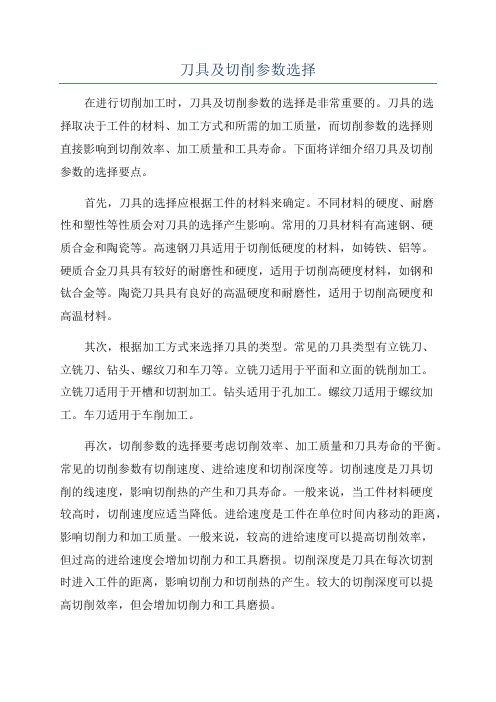
刀具及切削参数选择在进行切削加工时,刀具及切削参数的选择是非常重要的。
刀具的选择取决于工件的材料、加工方式和所需的加工质量,而切削参数的选择则直接影响到切削效率、加工质量和工具寿命。
下面将详细介绍刀具及切削参数的选择要点。
首先,刀具的选择应根据工件的材料来确定。
不同材料的硬度、耐磨性和塑性等性质会对刀具的选择产生影响。
常用的刀具材料有高速钢、硬质合金和陶瓷等。
高速钢刀具适用于切削低硬度的材料,如铸铁、铝等。
硬质合金刀具具有较好的耐磨性和硬度,适用于切削高硬度材料,如钢和钛合金等。
陶瓷刀具具有良好的高温硬度和耐磨性,适用于切削高硬度和高温材料。
其次,根据加工方式来选择刀具的类型。
常见的刀具类型有立铣刀、立铣刀、钻头、螺纹刀和车刀等。
立铣刀适用于平面和立面的铣削加工。
立铣刀适用于开槽和切割加工。
钻头适用于孔加工。
螺纹刀适用于螺纹加工。
车刀适用于车削加工。
再次,切削参数的选择要考虑切削效率、加工质量和刀具寿命的平衡。
常见的切削参数有切削速度、进给速度和切削深度等。
切削速度是刀具切削的线速度,影响切削热的产生和刀具寿命。
一般来说,当工件材料硬度较高时,切削速度应适当降低。
进给速度是工件在单位时间内移动的距离,影响切削力和加工质量。
一般来说,较高的进给速度可以提高切削效率,但过高的进给速度会增加切削力和工具磨损。
切削深度是刀具在每次切割时进入工件的距离,影响切削力和切削热的产生。
较大的切削深度可以提高切削效率,但会增加切削力和工具磨损。
此外,还应考虑冷却润滑剂的选择和使用。
合适的冷却润滑剂可以降低切削热的产生,减小工具磨损,提高加工质量。
综上所述,刀具及切削参数的选择需要考虑工件材料、加工方式和所需加工质量。
合理选择刀具类型和切削参数可以提高切削效率、加工质量和工具寿命。
在实际应用中,还需要根据具体情况进行调整和优化。
车刀的分类和选择

车刀的分类和选择车刀是机械车床上常用的切削工具之一,它对加工效率和加工质量都有重要影响。
选择适合的车刀分类和类型对于提高加工效率、降低切削成本至关重要。
本文将介绍车刀的分类和选择方法,帮助读者更好地理解和应用车刀。
一、车刀的分类根据车刀的结构和用途,可以将车刀分为以下几类:1. 工具刀片:广义上的车刀,通常由刀柄和刀片组成。
刀柄负责固定刀片,刀片进行切削工作。
工具刀片多用于外圆和内圆粗加工,适用于不同材料的车削操作。
2. 特殊刀片:用于特殊形状的车削。
如内外圆刀片、角刀片等。
特殊刀片适用于需要切削复杂外形的工件,提供更好的切削质量和加工精度。
3. 超硬刀片:采用高硬度材料制成的刀片,如金刚石、立方氮化硼等。
超硬刀片具有较高的硬度和耐磨性,适用于加工硬质材料如铸铁、合金钢等。
4. 镗刀:用于车削大孔径和参考表面。
镗刀采用特殊设计,能够提供更高的刚性和稳定性,适用于大直径工件和高精度加工。
5. 切断刀片:用于切断工件的刀片,有直刃和曲刃两种形式。
切断刀片适用于金属材料的切割,如车削工件的分离和切除。
二、车刀的选择选择适合的车刀是提高车削加工效率的关键。
以下是选择车刀时应考虑的因素:1. 加工材料:根据工件材料的不同,选择不同材质和刀片类型的车刀。
对于铸铁、不锈钢等材料,可选择高速钢刀片;对于合金钢、钛合金等硬材料,应选择超硬刀片。
2. 加工工艺:根据不同的车削工艺,选择合适的车刀类型。
对于粗车、精车和薄层车削等工艺,可以选择不同切削参数和刀片结构的车刀。
3. 切削条件:根据切削深度、进给速度和切削速度等切削条件,选择适合的刀片形状和材料。
对于大切削深度和高切削速度的加工,应选择具有高硬度和耐磨性的刀片。
4. 加工精度:根据对加工精度的要求,选择合适的刀片精度和结构。
如果需要高精度的加工,应选择刀片精度高、几何形状复杂的刀片。
5. 经济性:根据加工成本和刀具寿命,选择经济合理的车刀。
应选用具有长寿命和更换成本低的刀具,以优化切削成本。
切削参数优化范文

切削参数优化范文一、切削参数的选择和优化方法切削参数的选择和优化是一个复杂的过程,需要考虑到被加工材料的硬度、切削工具的材质和几何形状、切削速度和进给速度等因素。
常用的切削参数包括切削速度、进给速度、切削深度和切削宽度。
(一)试刀法试刀法是一种常用的切削参数选择的方法,通过试刀来确定最佳的切削参数。
试刀前需保证刀具采用合适的刀尖半径,试刀时应逐步调整切削速度、进给速度、切削深度和切削宽度,记录下每种参数对加工表面质量的影响,最终选择最佳的切削参数。
(二)试件法试件法是另一种常用的切削参数选择的方法,通过在试件上进行不同切削参数的加工,然后测量加工表面的质量指标,如表面粗糙度、加工硬度等,最终选择最佳的切削参数。
试件的材料和几何形状需要与实际加工件相似,以确保试削结果的准确性。
(三)数值模拟法数值模拟法是一种现代化的切削参数优化方法,通过建立数值模型,通过数值模拟分析不同切削参数对加工过程和加工表面质量的影响。
数值模拟法可以有效地提前预测切削参数对加工结果的影响,减少试刀试件的数量和试验时间,提高优化的效率和准确性。
二、切削参数的优化步骤切削参数的优化包括参数的选择和调整两个步骤。
(一)参数的选择1.切削速度的选择:切削速度的选择需要考虑材料的硬度、切削工具的材质和几何形状等因素。
一般来说,对于硬度较高的材料,需要选择较低的切削速度;对于切削刚度较低的加工工具,应采用较低的切削速度。
2.进给速度的选择:进给速度的选择需要考虑到切削力和加工表面质量。
较大的进给速度会增加切削力,但可以提高加工效率;较小的进给速度可以获得较好的表面质量,但加工效率较低。
在实际操作中,需要综合考虑进给速度和加工效率的平衡。
3.切削深度和切削宽度的选择:切削深度和切削宽度的选择需要考虑到刀具的切削能力和加工表面质量的要求。
在选择切削深度和切削宽度时,需要确保切削力在刀具的切削能力范围内,并满足加工表面质量的要求。
(二)参数的调整在确定了初步的切削参数之后,还需要进一步调整和优化。
数控机床加工铝合金的最佳切削参数选择方法
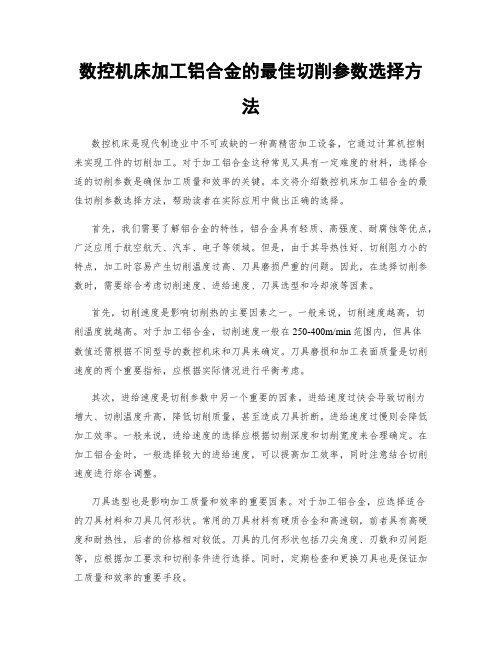
数控机床加工铝合金的最佳切削参数选择方法数控机床是现代制造业中不可或缺的一种高精密加工设备,它通过计算机控制来实现工件的切削加工。
对于加工铝合金这种常见又具有一定难度的材料,选择合适的切削参数是确保加工质量和效率的关键。
本文将介绍数控机床加工铝合金的最佳切削参数选择方法,帮助读者在实际应用中做出正确的选择。
首先,我们需要了解铝合金的特性。
铝合金具有轻质、高强度、耐腐蚀等优点,广泛应用于航空航天、汽车、电子等领域。
但是,由于其导热性好、切削阻力小的特点,加工时容易产生切削温度过高、刀具磨损严重的问题。
因此,在选择切削参数时,需要综合考虑切削速度、进给速度、刀具选型和冷却液等因素。
首先,切削速度是影响切削热的主要因素之一。
一般来说,切削速度越高,切削温度就越高。
对于加工铝合金,切削速度一般在250-400m/min范围内,但具体数值还需根据不同型号的数控机床和刀具来确定。
刀具磨损和加工表面质量是切削速度的两个重要指标,应根据实际情况进行平衡考虑。
其次,进给速度是切削参数中另一个重要的因素。
进给速度过快会导致切削力增大、切削温度升高,降低切削质量,甚至造成刀具折断。
进给速度过慢则会降低加工效率。
一般来说,进给速度的选择应根据切削深度和切削宽度来合理确定。
在加工铝合金时,一般选择较大的进给速度,可以提高加工效率,同时注意结合切削速度进行综合调整。
刀具选型也是影响加工质量和效率的重要因素。
对于加工铝合金,应选择适合的刀具材料和刀具几何形状。
常用的刀具材料有硬质合金和高速钢,前者具有高硬度和耐热性,后者的价格相对较低。
刀具的几何形状包括刀尖角度、刃数和刃间距等,应根据加工要求和切削条件进行选择。
同时,定期检查和更换刀具也是保证加工质量和效率的重要手段。
最后,冷却液的使用在加工铝合金时尤为重要。
冷却液不仅可以降低切削温度,还可以减少切削力和刀具磨损,提高加工质量和效率。
选择冷却液时应考虑其导热性、润滑性和抗腐蚀性等性能,同时要控制冷却液的喷射方式和压力,确保切削过程中刀具和工件始终处于良好的润滑和冷却状态。
数控机床加工不锈钢的切削参数选择与调整

数控机床加工不锈钢的切削参数选择与调整随着工业技术的不断发展,数控机床已经成为现代制造业中不可或缺的重要设备之一。
而在数控机床的加工过程中,如何正确选择和调整切削参数对于保证加工质量、提高加工效率具有极其重要的意义。
本文将介绍数控机床加工不锈钢的切削参数选择与调整的相关知识。
不锈钢作为一种常见的金属材料,其性质特殊,对于切削加工的要求较高。
因此,在数控机床加工不锈钢时,必须合理选择和调整切削参数,以确保加工过程的顺利进行和加工质量的提高。
首先,影响切削加工的关键参数之一是切削速度。
切削速度直接影响着切削速率和切削热量的分配。
对于不锈钢这种具有较高硬度的材料来说,较低的切削速度通常更为合适。
因此,在选择切削速度时,需要根据不锈钢的硬度、切削工具的材料以及切削深度等因素进行综合考虑。
在实际操作中,可以根据机床厂家提供的加工参数表进行参考,然后通过试切试验逐步调整切削速度,以获得最佳的加工效果。
其次,切削深度是影响切削加工的另一个重要参数。
切削深度指的是工件在一次切削过程中被减少的厚度。
对于不锈钢材料来说,由于其硬度较高,切削深度要适度控制,以避免刀具过度磨损和加工质量下降。
一般情况下,适当减小切削深度,每次进行多次较浅的切削,可以有效减小切削过程中的刀具磨损,提高加工的平整度和精度。
再次,切削进给量也是影响切削加工的重要参数之一。
切削进给量指的是刀具在切削过程中每分钟切削的长度。
在选择切削进给量时,需要综合考虑切削速度、切削深度和刀具的材质等因素。
切削进给量过大容易导致切削过程中产生过热,影响加工质量;而切削进给量过小则会造成加工效率低下。
因此,在实际操作中,选择适当的切削进给量,可以在保证加工质量的前提下提高加工效率。
除了上述几个主要的切削参数外,还有一些其他的次要参数也需要注意。
例如,切削液的选择和使用对于不锈钢的切削加工来说至关重要。
合适的切削液可以有效降低切削温度、延长刀具寿命,提高加工表面质量。
第三章切削条件的合理选择及刀具的选择

第三章切削条件的合理选择及刀具的选择一、切削条件的重要性切削条件的选择对于切削加工的效果具有重要的影响。
合理选择切削条件可以提高加工效率、延长刀具使用寿命、降低加工成本,因此在实际加工中,需要根据具体情况来选择合适的切削条件。
二、切削条件的选择要点1. 加工材料的硬度和刀具的硬度加工材料的硬度和刀具的硬度是选择切削条件的重要因素之一。
对于硬度较高的材料,需要选择刀具硬度更高的刀具来进行加工,以避免刀具过早损坏。
而对于较软的材料,可以选择硬度较低的刀具来降低成本。
2. 切削速度的选择切削速度的选择直接影响到加工效率。
一般情况下,切削速度越高,加工效率越高。
但是切削速度过高也会导致刀具磨损加剧,降低刀具使用寿命。
因此,在选择切削速度时,需要综合考虑加工效率和刀具寿命的因素。
3. 切削深度和切削宽度的选择切削深度和切削宽度的选择也是影响切削效果的重要因素。
切削深度过大可能会导致刀具振动,加剧刀具磨损。
切削宽度过大则容易引起加工表面粗糙度的提高。
因此,在选择切削深度和切削宽度时,需要根据材料的硬度和刀具的性能进行合理选择。
4. 切削液的选择切削液在切削过程中起到冷却刀具和减少摩擦的作用,对切削效果有着重要的影响。
选择合适的切削液可以有效地延长刀具的使用寿命,改善切削表面质量。
切削液的选择应综合考虑材料的切削性能,加工条件和环境因素等。
三、刀具的选择要点1. 刀具材料的选择刀具材料的选择直接影响到刀具的使用寿命和切削效果。
一般情况下,硬度较高的刀具材料可以提供更好的切削性能,但价格也更高。
因此,在选择刀具材料时,需要根据加工材料的硬度、切削条件和经济性等因素进行综合考虑。
2. 刀具的几何形状刀具的几何形状也是选择刀具的重要因素之一。
不同的切削任务需要选择不同形状的刀具,以获得更好的加工效果。
例如,对于粗车加工,可以选择具有大后角和大刀尖半径的刀具,以提高切削稳定性和表面质量。
3. 刀具的涂层选择涂层可以提高刀具的硬度、耐磨性和切削性能。
机械加工工艺中的技术要点
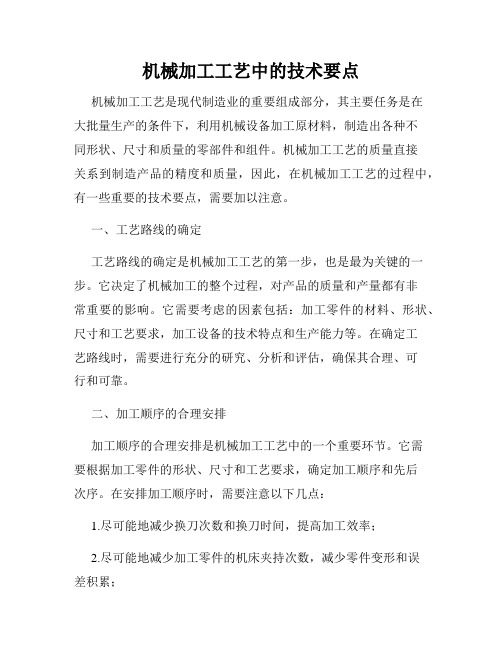
机械加工工艺中的技术要点机械加工工艺是现代制造业的重要组成部分,其主要任务是在大批量生产的条件下,利用机械设备加工原材料,制造出各种不同形状、尺寸和质量的零部件和组件。
机械加工工艺的质量直接关系到制造产品的精度和质量,因此,在机械加工工艺的过程中,有一些重要的技术要点,需要加以注意。
一、工艺路线的确定工艺路线的确定是机械加工工艺的第一步,也是最为关键的一步。
它决定了机械加工的整个过程,对产品的质量和产量都有非常重要的影响。
它需要考虑的因素包括:加工零件的材料、形状、尺寸和工艺要求,加工设备的技术特点和生产能力等。
在确定工艺路线时,需要进行充分的研究、分析和评估,确保其合理、可行和可靠。
二、加工顺序的合理安排加工顺序的合理安排是机械加工工艺中的一个重要环节。
它需要根据加工零件的形状、尺寸和工艺要求,确定加工顺序和先后次序。
在安排加工顺序时,需要注意以下几点:1.尽可能地减少换刀次数和换刀时间,提高加工效率;2.尽可能地减少加工零件的机床夹持次数,减少零件变形和误差积累;3.严格控制加工精度和表面质量要求,确保加工零件的精度和质量符合要求;4.合理安排加工时间和工艺路线,确保生产计划的顺利完成。
三、切削工具的选用切削工具是机械加工工艺中最为重要的部分,其质量和性能直接关系到加工零件的精度和表面质量。
因此,在选用切削工具时,需要考虑以下因素:1.工具的材料:刀具材料应根据加工材料的种类、硬度和切削性能特点而定,常用的刀具材料有高速钢、硬质合金、陶瓷等;2.工具的几何形状:刀具的几何形状应适应加工零件的外形和内部轮廓,确保刀具能够正常切削;3.工具的涂层:涂层可以提高刀具的耐磨性和切削性能,因此在选用刀具时,应优先考虑涂层刀具;4.工具的切削参数:刀具的切削参数应根据加工零件的材料、硬度、切削性能和表面要求来确定,包括切削速度、进给量和切削深度等。
四、机床设备的调整和检修机床设备的调整和检修是机械加工工艺中一个非常重要的环节。
C5116a单柱车床型号操作步骤说明

C5116a单柱车床型号操作步骤说明C5116a单柱车床是一种常用的金属切削机床,通常用于加工各种精密零件。
本文将详细介绍C5116a单柱车床的操作步骤,以帮助使用者正确进行操作。
步骤一:准备工作在操作C5116a单柱车床之前,首先需要对机床进行准备工作。
这包括检查机床的各个部分是否正常运行,例如润滑系统、刀具紧固装置、电气控制系统等。
确保机床的各项功能正常后,再进行下一步操作。
步骤二:夹紧工件在进行车削加工之前,需要先夹紧工件。
将工件放置在车床的工作台上,并使用卡盘或夹具将其夹紧。
夹紧时要确保工件与夹具之间有足够的摩擦力,以防止工件在车削过程中滑动或移位。
步骤三:选择切削工具根据需要加工的工件材料和形状,选择合适的切削工具。
将切削工具安装到车床的主轴上,并进行正确的调整和紧固。
切削工具的选择和调整对加工质量和效率有重要影响,因此需要仔细进行。
步骤四:设置车床参数在C5116a单柱车床上,操作者需要设置一些参数,以确保加工过程的准确性和稳定性。
这些参数包括进给速度、主轴转速、切削深度等。
根据工件材料和形状的不同,合理设置这些参数,以获得最佳加工效果。
步骤五:调整刀具位置在开始车削之前,需要调整刀具的位置。
根据工件的几何形状和加工要求,通过手动或自动调整刀架位置,使切削工具与工件接触。
调整后,要确保刀具与工件之间有适当的间隙,以防止切削过程中的碰撞和损坏。
步骤六:开始车削一切准备就绪后,可以开始进行实际的车削操作。
根据设定的参数,启动车床,让切削工具开始旋转。
同时,通过进给机构控制工件和切削工具之间的相对运动,进行切削加工。
在车削过程中,要注意观察工件表面的状况,及时调整参数和刀具位置,以确保加工质量。
步骤七:检查加工结果车削完成后,需要检查加工结果。
使用测量工具(例如千分尺、千分表等)对加工后的工件尺寸进行测量,以确认是否达到要求。
同时,检查工件表面的光洁度和平整度,确保加工质量良好。
步骤八:清理和维护完成车削操作后,要对机床进行清理和维护。
机械专业毕业设计外文翻译--选择最佳工具,几何形状和切削条件

附录附录1:英文原文Selection of optimum tool geometry and cutting conditionsusing a surface roughness prediction model for end milling Abstract Influence of tool geometry on the quality of surface produced is well known and hence any attempt to assess the performance of end milling should include the tool geometry. In the present work, experimental studies have been conducted to see the effect of tool geometry (radial rake angle and nose radius) and cutting conditions (cutting speed and feed rate) on the machining performance during end milling of medium carbon steel. The first and second order mathematical models, in terms of machining parameters, were developed for surface roughness prediction using response surface methodology (RSM) on the basis of experimental results. The model selected for optimization has been validated with the Chi square test. The significance of these parameters on surface roughness has been established with analysis of variance. An attempt has also been made to optimize the surface roughness prediction model using genetic algorithms (GA). The GA program gives minimum values of surface roughness and their respective optimal conditions.1 IntroductionEnd milling is one of the most commonly used metal removal operations in industry because of its ability to remove material faster giving reasonably good surface quality. It is used in a variety of manufacturing industries including aerospace and automotive sectors, where quality is an important factor in the production of slots, pockets, precision moulds and dies. Greater attention is given to dimensional accuracy and surface roughness of products by the industry these days. Moreover, surface finish influences mechanical properties such as fatigue behaviour, wear, corrosion, lubrication and electrical conductivity. Thus, measuring and characterizing surface finish can be considered for predicting machining performance.Surface finish resulting from turning operations has traditionally received considerable research attention, where as that of machining processes using multipoint cutters, requires attention by researchers. As these processes involve large number of parameters, it would be difficult to correlate surface finish with other parameters just by conducting experiments. Modelling helps to understand this kind of process better. Though some amount of work has been carried out to develop surface finish prediction models in the past, the effect of tool geometry has received little attention. However, the radial rake angle has a major affect on the powerconsumption apart from tangential and radial forces. It also influences chip curling and modifies chip flow direction. In addition to this, researchers [1] have also observed that the nose radius plays a significant role in affecting the surface finish. Therefore the development of a good model should involve the radial rake angle and nose radius along with other relevant factors.Establishment of efficient machining parameters has been a problem that has confronted manufacturing industries for nearly a century, and is still the subject of many studies. Obtaining optimum machining parameters is of great concern in manufacturing industries, where the economy of machining operation plays a key role in the competitive market. In material removal processes, an improper selection of cutting conditions cause surfaces with high roughness and dimensional errors, and it is even possible that dynamic phenomena due to auto excited vibrations may set in [2]. In view of the significant role that the milling operation plays in today‟s manufacturing world, there is a need to optimize the machining parameters for this operation. So, an effort has been made in this paper to see the influence of tool geometry(radial rake angle and nose radius) and cutting conditions(cutting speed and feed rate) on the surface finish produced during end milling of medium carbon steel. The experimental results of this work will be used to relate cutting speed, feed rate, radial rake angle and nose radius with the machining response i.e. surface roughness by modelling. The mathematical models thus developed are further utilized to find the optimum process parameters using genetic algorithms.2 ReviewProcess modelling and optimization are two important issues in manufacturing. The manufacturing processes are characterized by a multiplicity of dynamically interacting process variables. Surface finish has been an important factor of machining in predicting performance of any machining operation. In order to develop and optimize a surface roughness model, it is essential to understand the current status of work in this area.Davis et al. [3] have investigated the cutting performance of five end mills having various helix angles. Cutting tests were performed on aluminium alloy L 65 for three milling processes (face, slot and side), in which cutting force, surface roughness and concavity of a machined plane surface were measured. The central composite design was used to decide on the number of experiments to be conducted. The cutting performance of the end mills was assessed using variance analysis. The affects of spindle speed, depth of cut and feed rate on the cutting force and surface roughness were studied. The investigation showed that end mills with left hand helix angles are generally less cost effective than those with right hand helix angles. There is no significant difference between up milling and down milling with regard tothe cutting force, although the difference between them regarding the surface roughness was large. Bayoumi et al. [4]have studied the affect of the tool rotation angle, feed rate and cutting speed on the mechanistic process parameters (pressure, friction parameter) for end milling operation with three commercially available workpiece materials, 11 L 17 free machining steel, 62- 35-3 free machining brass and 2024 aluminium using a single fluted HSS milling cutter. It has been found that pressure and friction act on the chip – tool interface decrease with the increase of feed rate and with the decrease of the flow angle, while the cutting speed has a negligible effect on some of the material dependent parameters. Process parameters are summarized into empirical equations as functions of feed rate and tool rotation angle for each work material. However, researchers have not taken into account the effects of cutting conditions and tool geometry simultaneously; besides these studies have not considered the optimization of the cutting process.As end milling is a process which involves a large number f parameters, combined influence of the significant parameters an only be obtained by modelling. Mansour and Abdallaet al. [5] have developed a surface roughness model for the end milling of EN32M (a semi-free cutting carbon case hardening steel with improved merchantability). The mathematical model has been developed in terms of cutting speed, feed rate and axial depth of cut. The affect of these parameters on the surface roughness has been carried out using response surface methodology (RSM). A first order equation covering the speed range of 30–35 m/min and a second order equation covering the speed range of 24–38 m/min were developed under dry machining conditions. Alauddin et al. [6] developed a surface roughness model using RSM for the end milling of 190 BHN steel. First and second order models were constructed along with contour graphs for the selection of the proper combination of cutting speed and feed to increase the metal removal rate without sacrificing surface quality. Hasmi et al. [7] also used the RSM model for assessing the influence of the workpiece material on the surface roughness of the machined surfaces. The model was developed for milling operation by conducting experiments on steel specimens. The expression shows, the relationship between the surface roughness and the various parameters; namely, the cutting speed, feed and depth of cut. The above models have not considered the affect of tool geometry on surface roughness.Since the turn of the century quite a large number of attempts have been made to find optimum values of machining parameters. Uses of many methods have been reported in the literature to solve optimization problems for machining parameters. Jain and Jain [8] have used neural networks for modeling and optimizing the machining conditions. The results have been validated by comparing the optimized machining conditions obtained using genetic algorithms. Suresh et al. [9] have developed a surface roughness prediction model for turning mild steel using a response surface methodology to produce the factor affects of the individual process parameters. They have also optimized the turning process using the surface roughness prediction model as theobjective function. Considering the above, an attempt has been made in this work to develop a surface roughness model with tool geometry and cutting conditions on the basis of experimental results and then optimize it for the selection of these parameters within the given constraints in the end milling operation.3 MethodologyIn this work, mathematical models have been developed using experimental results with the help of response surface methodolog y. The purpose of developing mathematical models relating the machining responses and their factors is to facilitate the optimization of the machining process. This mathematical model has been used as an objective function and the optimization was carried out with the help of genetic algorithms.3.1 Mathematical formulationResponse surface methodology(RSM) is a combination of mathematical and statistical techniques useful for modelling and analyzing the problems in which several independent variables influence a dependent variable or response. The mathematical models commonly used are represented by:where Y is the machining response, ϕ is the response function and S, f , α, r are milling variables and ∈ is the error which is normally distributed about the observed response Y with zero mean.The relationship between surface roughness and other independent variables can be represented as follows,where C is a constant and a, b, c and d are exponents.To facilitate the determination of constants and exponents, this mathematical model will have to be linearized by performing a logarithmic transformation as follows:The constants and exponents C, a, b, c and d can be determined by the method of least squares. The first order linear model, developed from the above functional relationship using least squares method, can be represented as follows:where Y1 is the estimated response based on the first-order equation, Y is the measured surface roughness on a logarithmic scale, x0 = 1 (dummy variable), x1, x2, x3 and x4 are logarithmic transformations of cutting speed, feed rate, radial rake angle and nose radius respectively, ∈is the experimental error and b values are the estimates of corresponding parameters.The general second order polynomial response is as given below:where Y2 is the estimated response based on the second order equation. The parameters, i.e. b0, b1, b2, b3, b4, b12, b23, b14, etc. are to be estimated by the method of least squares. Validity ofthe selected model used for optimizing the process parameters has been tested with the help of statistical tests, such as F-test, chi square test, etc. [10].3.2 Optimization using genetic algorithmsMost of the researchers have used traditional optimization techniques for solving machining problems. The traditional methods of optimization and search do not fare well over a broad spectrum of problem domains. Traditional techniques are not efficient when the practical search space is too large. These algorithms are not robust. They are inclined to obtain a local optimal solution. Numerous constraints and number of passes make the machining optimization problem more complicated. So, it was decided to employ genetic algorithms as an optimization technique. GA come under the class of non-traditional search and optimization techniques. GA are different from traditional optimization techniques in the following ways:1.GA work with a coding of the parameter set, not the parameter themselves.2.GA search from a population of points and not a single point.3.GA use information of fitness function, not derivatives or other auxiliary knowledge.4.GA use probabilistic transition rules not deterministic rules.5.It is very likely that the expected GA solution will be the global solution.Genetic algorithms (GA) form a class of adaptive heuristics based on principles derived from the dynamics of natural population genetics. The searching process simulates the natural evaluation of biological creatures and turns out to be an intelligent exploitation of a random search. The mechanics of a GA is simple, involving copying of binary strings. Simplicity of operation and computational efficiency are the two main attractions of the genetic algorithmic approach. The computations are carried out in three stages to get a result in one generation or iteration. The three stages are reproduction, crossover and mutation.In order to use GA to solve any problem, the variable is typically encoded into a string (binary coding) or chromosome structure which represents a possible solution to the given problem. GA begin with a population of strings (individuals) created at random. The fitness of each individual string is evaluated with respect to the given objective function. Then this initial population is operated on by three main operators – reproduction cross over and mutation– to create, hopefully, a better population. Highly fit individuals or solutions are given the opportunity to reproduce by exchanging pieces of their genetic information, in the crossover procedure, with other highly fit individuals. This produces new “offspring” solutions, which share some characteristics taken from both the parents. Mutation is often applied after crossover by altering some genes (i.e. bits) in the offspring. The offspring can either replace the whole population (generational approach) or replace less fit individuals (steady state approach). This new population is further evaluated andtested for some termination criteria. The reproduction-cross over mutation- evaluation cycle is repeated until the termination criteria are met.4 Experimental detailsFor developing models on the basis of experimental data, careful planning of experimentation is essential. The factors considered for experimentation and analysis were cutting speed, feed rate, radial rake angle and nose radius.4.1 Experimental designThe design of experimentation has a major affect on the number of experiments needed. Therefore it is essential to have a well designed set of experiments. The range of values of each factor was set at three different levels, namely low, medium and high as shown in Table 1. Based on this, a total number of 81 experiments (full factorial design), each having a combination of different levels of factors, as shown in Table 2, were carried out.The variables were coded by taking into account the capacity and limiting cutting conditions of the milling machine. The coded values of variables, to be used in Eqs. 3 and 4, were obtained from the following transforming equations:where x1 is the coded value of cutting speed (S), x2 is the coded value of the feed rate ( f ), x3 is the coded value of radial rake angle(α) and x4 is the coded value of nose radius (r).4.2 ExperimentationA high precision …Rambaudi Rammatic 500‟ CNC milling machine, with a vertical milling head, was used for experimentation. The control system is a CNC FIDIA-12 compact. The cutting tools, used for the experimentation, were solid coated carbide end mill cutters of different radial rake angles and nose radii (WIDIA: DIA20 X FL38 X OAL 102 MM). The tools are coated with TiAlN coating. The hardness, density and transverse rupture strength are 1570 HV 30, 14.5 gm/cm3 and 3800 N/mm2 respectively.AISI 1045 steel specimens of 100×75 mm and 20 mm thickness were used in the present study. All the specimens were annealed, by holding them at 850 ◦C for one hour and then cooling them in a furnace. The chemical analysis of specimens is presented in Table 3. The hardness of the workpiece material is 170 BHN. All the experiments were carried out at a constant axial depth of cut of 20 mm and a radial depth of cut of 1 mm. The surface roughness (response) was measured with Talysurf-6 at a 0.8 mm cut-off value. An average of four measurements was used as a response value.5 Results and discussionThe influences of cutting speed, feed rate, radial rake angle and nose radius have been assessed by conducting experiments. The variation of machining response with respect to the variables was shown graphically in Fig. 1. It is seen from these figures that of the four dependent parameters, radial rake angle has definite influence on the roughness of the surface machined using an end mill cutter. It is felt that the prominent influence of radial rake angle on the surface generation could be due to the fact that any change in the radial rake angle changes the sharpness of the cutting edge on the periphery, i.e changes the contact length between the chip and workpiece surface. Also it is evident from the plots that as the radial rake angle changes from 4◦to 16◦, the surface roughness decreases and then increases. Therefore, it may be concluded here that the radial rake angle in the range of 4◦to 10◦would give a better surface finish. Figure 1 also shows that the surface roughness decreases first and then increases with the increase in the nose radius. This shows that there is a scope for finding the optimum value of the radial rake angle and nose radius for obtaining the best possible quality of the surface. It was also found that the surface roughness decreases with an increase in cutting speed and increases as feed rate increases. It could also be observed that the surface roughness was a minimum at the 250 m/min speed, 200 mm/min feed rate, 10◦radial rake angle and 0.8 mm nose radius. In order to understand the process better, the experimental results can be used to develop mathematical models using RSM. In this work, a commercially available mathematical software package (MATLAB) was used for the computation of the regression of constants and exponents.5.1 The roughness modelUsing experimental results, empirical equations have been obtained to estimate surface roughness with the significant parameters considered for the experimentation i.e. cutting speed, feed rate, radial rake angle and nose radius. The first order model obtained from the above functional relationship using the RSM method is as follows:The transformed equation of surface roughness prediction is as follows:Equation 10 is derived from Eq. 9 by substituting the coded values of x1, x2, x3 and x4 in terms of ln s, ln f , lnαand ln r. The analysis of the variance (ANOVA) and the F-ratio test have been performed to justify the accuracy of the fit for the mathematical model. Since the calculated values of the F-ratio are less than the standard values of the F-ratio for surface roughness as shown in Table 4, the model is adequate at 99% confidence level to represent the relationship between the machining response and the considered machining parameters of the end milling process.The multiple regression coefficient of the first order model was found to be 0.5839. This shows that the first order model can explain the variation in surface roughness to the extent of58.39%. As the first order model has low predictability, the second order model has been developed to see whether it can represent better or not.The second order surface roughness model thus developed is as given below:where Y2 is the estimated response of the surface roughness on a logarithmic scale, x1, x2, x3 and x4 are the logarithmic transformation of speed, feed, radial rake angle and nose radius. The data of analysis of variance for the second order surface roughness model is shown in Table 5.Since F cal is greater than F0.01, there is a definite relationship between the response variable and independent variable at 99% confidence level. The multiple regression coefficient of the second order model was found to be 0.9596. On the basis of the multiple regression coefficient (R2), it can be concluded that the second order model was adequate to represent this process. Hence the second order model was considered as an objective function for optimization using genetic algorithms. This second order model was also validated using the chi square test. The calculated chi square value of the model was 0.1493 and them tabulated value at χ2 0.005 is 52.34, as shown in Table 6, which indicates that 99.5% of the variability in surface roughness was explained by this model.Using the second order model, the surface roughness of the components produced by end milling can be estimated with reasonable accuracy. This model would be optimized using genetic algorithms (GA).5.2 The optimization of end millingOptimization of machining parameters not only increases the utility for machining economics, but also the product quality toa great extent. In this context an effort has been made to estimate the optimum tool geometry and machining conditions to produce the best possible surface quality within the constraints.The constrained optimization problem is stated as follows: Minimize Ra using the model given here:where xil and xiu are the upper and lower bounds of process variables xi and x1, x2, x3, x4 are logarithmic transformation of cutting speed, feed, radial rake angle and nose radius.The GA code was developed using MATLAB. This approach makes a binary coding system to represent the variables cutting speed (S), feed rate ( f ), radial rake angle (α) and nose radius (r), i.e. each of these variables is represented by a ten bit binary equivalent, limiting the total string length to 40. It is known as a chromosome. The variables are represented as genes (substrings) in the chromosome. The randomly generated 20 such chromosomes (population size is 20), fulfillingthe constraints on the variables, are taken in each generation. The first generation is called the initial population. Once the coding of the variables has been done, then the actual decoded values for the variables are estimated using the following formula:where xi is the actual decoded value of the cutting speed, feed rate, radial rake angle and nose radius, x(L) i is the lower limit and x(U) i is the upper limit and li is the substring length, which is equal to ten in this case.Using the present generation of 20 chromosomes, fitness values are calculated by the following transformation:where f(x) is the fitness function and Ra is the objective function.Out of these 20 fitness values, four are chosen using the roulette-wheel selection scheme. The chromosomes corresponding to these four fitness values are taken as parents. Then the crossover and mutation reproduction methods are applied to generate 20 new chromosomes for the next generation. This processof generating the new population from the old population is called one generation. Many such generations are run till the maximum number of generations is met or the average of four selected fitness values in each generation becomes steady. This ensures that the optimization of all the variables (cutting speed, feed rate, radial rake angle and nose radius) is carried out simultaneously. The final statistics are displayed at the end of all iterations. In order to optimize the present problem using GA, the following parameters have been selected to obtain the best possible solution with the least computational effort:Table 7 shows some of the minimum values of the surface roughness predicted by the GA program with respect to input machining ranges, and Table 8 shows the optimum machining conditions for the corresponding minimum values of the surface roughness shown in Table 7. The MRR given in Table 8 was calculated bywhere f is the table feed (mm/min), aa is the axial depth of cut (20 mm) and ar is the radial depth of cut (1 mm).It can be concluded from the optimization results of the GA program that it is possible to select a combination of cutting speed, feed rate, radial rake angle and nose radius for achieving the best possible surface finish giving a reasonably good material removal rate. This GA program provides optimum machining conditions for the corresponding given minimum values of the surface roughness. The application of the genetic algorithmic approach to obtain optimal machining conditions will be quite useful at the computer aided process planning (CAPP) stage in the production of high quality goods with tight tolerances by a variety of machining operations, and in the adaptive control of automated machine tools. With the known boundaries of surface roughness and machining conditions, machining could be performed with a relatively high rate of success with the selected machining conditions.6 ConclusionsThe investigations of this study indicate that the parameters cutting speed, feed, radial rake angle and nose radius are the primary actors influencing the surface roughness of medium carbon steel uring end milling. The approach presented in this paper provides n impetus to develop analytical models, based on experimental results for obtaining a surface roughness model using the response surface methodology. By incorporating the cutter geometry in the model, the validity of the model has been enhanced. The optimization of this model using genetic algorithms has resulted in a fairly useful method of obtaining machining parameters in order to obtain the best possible surface quality.中文翻译选择最佳工具,几何形状和切削条件利用表面粗糙度预测模型端铣摘要:刀具几何形状对工件表面质量产生的影响是人所共知的,因此,任何成型面端铣设计应包括刀具的几何形状。
任何切削加工都必须具备三个基本条件
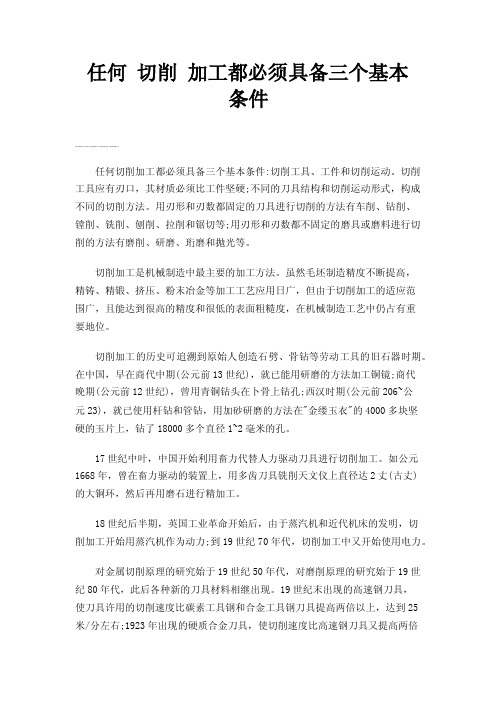
任何切削加工都必须具备三个基本条件任何切削加工都必须具备三个基本条件:切削工具、工件和切削运动。
切削工具应有刃口,其材质必须比工件坚硬;不同的刀具结构和切削运动形式,构成不同的切削方法。
用刃形和刃数都固定的刀具进行切削的方法有车削、钻削、镗削、铣削、刨削、拉削和锯切等;用刃形和刃数都不固定的磨具或磨料进行切削的方法有磨削、研磨、珩磨和抛光等。
切削加工是机械制造中最主要的加工方法。
虽然毛坯制造精度不断提高,精铸、精锻、挤压、粉末冶金等加工工艺应用日广,但由于切削加工的适应范围广,且能达到很高的精度和很低的表面粗糙度,在机械制造工艺中仍占有重要地位。
切削加工的历史可追溯到原始人创造石劈、骨钻等劳动工具的旧石器时期。
在中国,早在商代中期(公元前13世纪),就已能用研磨的方法加工铜镜;商代晚期(公元前12世纪),曾用青铜钻头在卜骨上钻孔;西汉时期(公元前206~公元23),就已使用杆钻和管钻,用加砂研磨的方法在"金缕玉衣"的4000多块坚硬的玉片上,钻了18000多个直径1~2毫米的孔。
17世纪中叶,中国开始利用畜力代替人力驱动刀具进行切削加工。
如公元1668年,曾在畜力驱动的装置上,用多齿刀具铣削天文仪上直径达2丈(古丈)的大铜环,然后再用磨石进行精加工。
18世纪后半期,英国工业革命开始后,由于蒸汽机和近代机床的发明,切削加工开始用蒸汽机作为动力;到19世纪70年代,切削加工中又开始使用电力。
对金属切削原理的研究始于19世纪50年代,对磨削原理的研究始于19世纪80年代,此后各种新的刀具材料相继出现。
19世纪末出现的高速钢刀具,使刀具许用的切削速度比碳素工具钢和合金工具钢刀具提高两倍以上,达到25米/分左右;1923年出现的硬质合金刀具,使切削速度比高速钢刀具又提高两倍左右;30年代以后出现的金属陶瓷和超硬材料(人造金刚石和立方氮化硼),进一步提高了切削速度和加工精度。
随着机床和刀具的不断发展,切削加工的精度、效率和自动化程度不断提高,应用范围也日益扩大,从而大大促进了现代机械制造业的发展。
机械加工的加工能力和工具选择
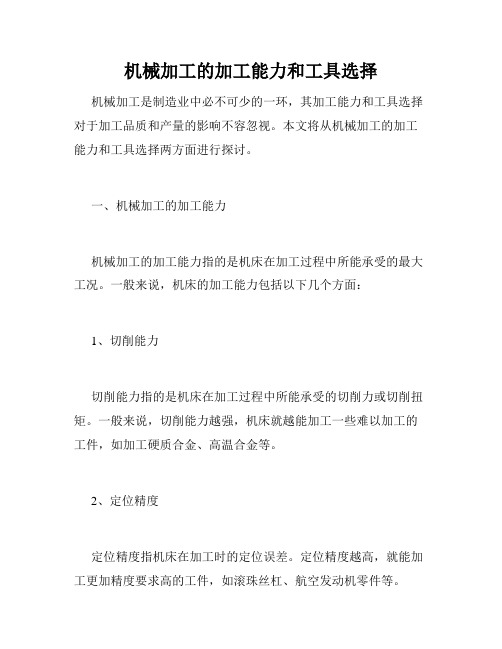
机械加工的加工能力和工具选择机械加工是制造业中必不可少的一环,其加工能力和工具选择对于加工品质和产量的影响不容忽视。
本文将从机械加工的加工能力和工具选择两方面进行探讨。
一、机械加工的加工能力机械加工的加工能力指的是机床在加工过程中所能承受的最大工况。
一般来说,机床的加工能力包括以下几个方面:1、切削能力切削能力指的是机床在加工过程中所能承受的切削力或切削扭矩。
一般来说,切削能力越强,机床就越能加工一些难以加工的工件,如加工硬质合金、高温合金等。
2、定位精度定位精度指机床在加工时的定位误差。
定位精度越高,就能加工更加精度要求高的工件,如滚珠丝杠、航空发动机零件等。
3、重复定位精度重复定位精度指机床在多次加工同一件工件时,定位误差的重复性。
重复定位精度越高,就能更好地保证工件的质量和加工效率。
4、加工几何精度加工几何精度指机床在加工过程中所能保证的工件几何形状和尺寸的误差范围。
加工几何精度越高,就能加工更加精度要求高的工件,如光学元件、模具等。
5、表面粗糙度表面粗糙度指机床在加工过程中所能保证的工件表面光洁度。
表面粗糙度越小,工件表面越光滑,表面处理也就越容易。
以上几个方面是机械加工的加工能力的主要方面,不同的加工场合需要不同的加工能力,因此在选择机床时需要根据具体情况进行选择。
二、机械加工的工具选择机械加工中的工具选择是影响加工品质和产量的重要因素。
不同的加工工件和材料需要不同的加工工具,下面将分别介绍。
1、铣削工具铣削是一种在工件上旋转的刀具不断进行切削,以达到加工工件的目的。
铣削工具根据切削方式可分为面铣刀和立铣刀两种,根据材料可分为硬质合金铣刀和高速钢铣刀两种。
对于硬质材料和锻造件等较难加工的工件,应选用硬质合金铣刀,而对于加工简单工件和材料要求不高的工件,则可以选用高速钢铣刀。
2、车削工具车削是一种利用刀具对工件进行旋转切削的加工方式。
车床上车刀的选择应根据不同的加工形式和材料进行选择。
对于较硬的材料和精度要求高的工件,应选用硬质合金车刀,而对于加工简单的轻型零件,则可以使用普通车刀。
刀具几何参数的选择

刀具几何参数的选择刀具的切削性能主要是由刀具材料的性能和刀具几何参数两方面打算的。
刀具几何参数的选择是否合理对切削力、切削温度及刀具磨损有显著影响。
选择刀具的几何参数要综合考虑工件材料、刀具材料、刀具类型及其他加工条件(如切削用量、工艺系统刚性及机床功率等)的影响。
一、前角的选择前角是刀具上最重要的几何参数之一。
增大前角可以减小切削变形,降低切削力和切削温度;但过大的前角使刀具楔角减小,刀刃强度下降,刀头散热体积减小,刀具温度上升,使刀具寿命下降。
针对某一详细加工条件,客观上有一个最合理的前角取值。
工件材料的强度、硬度较低时,前角应取得大些;加工塑性材料宜取较大的前角,加工脆性材料宜取较小的前角。
刀具材料韧性好时宜取较大前角,硬质合金刀具就应取比高速钢刀具较小的前角。
粗加工时,为保证刀刃强度,应取小前角;精加工时,为提高表面质量,可取较大前角。
工艺系统刚性较差时,应取较大前角。
为减小刃形误差,成形刀具的前角应取较小值。
用硬质合金刀具加工中碳钢工件时,通常取;加工灰铸铁工件时,通常取。
二、后角的选择后角的主要功用是减小切削过程中刀具后刀面与工件之间的摩擦。
较大的后角可减小刀具后刀面上的摩擦,提高已加工表面质量。
在磨钝标准取值相同时,后角较大的刀具,磨损到磨钝标准时,磨去的刀具材料较多,刀具寿命较长;但是过大的后角会使刀具楔角显著减小,减弱切削刃强度,减小刀头散热体积,导致刀具寿命降低。
可按下列原则正确选择合理后角值。
切削厚度(或进给量)较小时,宜取较大的后角。
进行粗加工、强力切削和承受冲击载荷的刀具,为保证刀刃强度,宜取较小后角。
工件材料硬度、强度较高时,宜取较小的后角;工件材料较软、塑性较大时,宜取较大后角;切削脆性材料,宜取较小后角。
对精度要求高的定尺寸刀具(例如铰刀),宜取较小的后角;由于在径向磨损量NB 取值相同的条件下,后角较小时允许磨掉的刀具材料较多,刀具寿命长。
车削中碳钢和铸铁工件时,车刀后角通常取为6~8°。
刀具切削参数的选用原则

刀具切削参数的选用原则刀具切削参数的选用原则刀具是机械加工中非常重要的一种工具,不同类型、不同材质的工件需要使用不同的刀具才能进行加工。
而刀具在使用过程中,又需要根据加工对象的特点和工艺要求等因素选择合适的切削参数。
本文将从切削参数的角度介绍刀具的选用原则。
1. 刀具的基本参数刀具的基本参数包括刀具形状、尺寸、材料、刃数、刃口角度和刃面处理等。
在选择刀具时,需要考虑工件的材料、形状、尺寸和加工要求,以及切削方式和切削条件等因素,选用适合的切削刃口角度和刃面处理方式,以达到最佳的加工效果。
2. 切削速度切削速度是刀具运转的速度,它是切削参数中最重要的一个参数。
切削速度的高低直接影响到刀具的磨损率和工件表面质量。
在选择切削参数时,需要考虑切削速度与加工材料的硬度等参数的相互关系,尽可能达到最佳的切削速度,以保证切削效率和加工质量。
3. 进给速度进给速度指刀具在工件上行进的速度。
它受到刀具的刃数、工件材料硬度、切削深度、切削速度、刀具材料和润滑冷却等因素的影响。
在选择进给速度时,需要考虑它对切削效率和加工质量的影响,尽量选择适当的进给速度以保证切削效果和刀具寿命。
4. 刀具转速刀具转速是刀具在工件上切削时的转速。
在选择刀具转速时,应考虑工件材料、切削深度、切削速度、刀具材料和润滑冷却等因素的影响。
对于不同种类的刀具,选择不同的刀具转速,以保证加工质量和切削效率。
5. 刃口角度刃口角度是切削刃口与工件表面的夹角大小,它影响到切屑形状和切削力的大小。
在选择刃口角度时,需要考虑工件材料和切削对象的几何形状等因素,以达到最佳的切削效果。
6. 切削深度切削深度是刀具在加工过程中切削的深度。
在选择切削深度时,需要考虑刀具的强度和刚度,以及工件材料和加工对象的几何形状等因素,以达到最佳的加工效果,同时保证刀具的寿命。
7. 冷却润滑刀具加工过程中,需要保证刀具和工件的表面保持充分的润滑,以减少切削温度和减缓刀具的磨损。
机械切削工具的选择与使用技巧
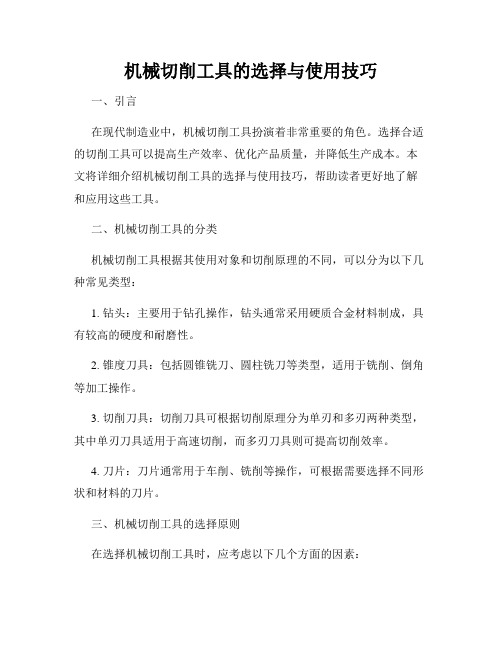
机械切削工具的选择与使用技巧一、引言在现代制造业中,机械切削工具扮演着非常重要的角色。
选择合适的切削工具可以提高生产效率、优化产品质量,并降低生产成本。
本文将详细介绍机械切削工具的选择与使用技巧,帮助读者更好地了解和应用这些工具。
二、机械切削工具的分类机械切削工具根据其使用对象和切削原理的不同,可以分为以下几种常见类型:1. 钻头:主要用于钻孔操作,钻头通常采用硬质合金材料制成,具有较高的硬度和耐磨性。
2. 锥度刀具:包括圆锥铣刀、圆柱铣刀等类型,适用于铣削、倒角等加工操作。
3. 切削刀具:切削刀具可根据切削原理分为单刃和多刃两种类型,其中单刃刀具适用于高速切削,而多刃刀具则可提高切削效率。
4. 刀片:刀片通常用于车削、铣削等操作,可根据需要选择不同形状和材料的刀片。
三、机械切削工具的选择原则在选择机械切削工具时,应考虑以下几个方面的因素:1. 切削材料:不同的切削材料对工具的要求不同,如切削硬度高的材料需要具有较高硬度和耐磨性的刀具。
2. 加工要求:根据不同加工要求选择合适的刀具类型和规格,如对于高速切削需求,可选择单刃刀具。
3. 切削参数:包括切削速度、进给量等参数,需要根据实际情况选取合适的工具。
4. 厂商信誉:选择有一定知名度和信誉的切削工具厂商,保证产品质量和售后服务。
四、机械切削工具的使用技巧正确的使用机械切削工具可以延长其使用寿命并提高加工效率,以下是一些常用的使用技巧:1. 安装正确:在使用机械切削工具之前,要确保正确安装,包括紧固刀柄、调整刀具角度等。
2. 控制切削参数:根据加工要求和切削工具的特性,合理控制切削速度、进给量等参数,以提高加工效率和工具寿命。
3. 定期保养:定期检查和保养切削工具,包括清洁、润滑等,以确保工具正常运行和寿命。
4. 合理刀具刀具:对于多刃刀具,需合理安排刀片的使用,及时更换磨损的刀片,以保证加工质量。
五、机械切削工具的常见问题与解决方法在使用机械切削工具过程中,可能会出现一些常见问题,以下是一些解决方法:1. 刀具磨损:当刀具磨损过度时,会影响切削质量和效率。
机加工工艺措施
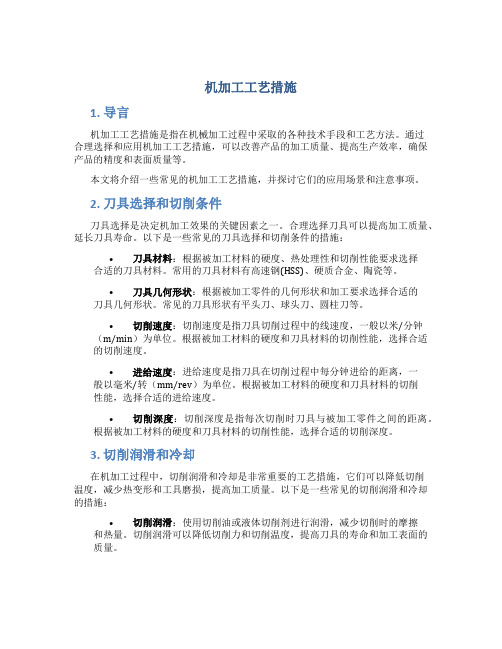
机加工工艺措施1. 导言机加工工艺措施是指在机械加工过程中采取的各种技术手段和工艺方法。
通过合理选择和应用机加工工艺措施,可以改善产品的加工质量、提高生产效率,确保产品的精度和表面质量等。
本文将介绍一些常见的机加工工艺措施,并探讨它们的应用场景和注意事项。
2. 刀具选择和切削条件刀具选择是决定机加工效果的关键因素之一。
合理选择刀具可以提高加工质量、延长刀具寿命。
以下是一些常见的刀具选择和切削条件的措施:•刀具材料:根据被加工材料的硬度、热处理性和切削性能要求选择合适的刀具材料。
常用的刀具材料有高速钢(HSS)、硬质合金、陶瓷等。
•刀具几何形状:根据被加工零件的几何形状和加工要求选择合适的刀具几何形状。
常见的刀具形状有平头刀、球头刀、圆柱刀等。
•切削速度:切削速度是指刀具切削过程中的线速度,一般以米/分钟(m/min)为单位。
根据被加工材料的硬度和刀具材料的切削性能,选择合适的切削速度。
•进给速度:进给速度是指刀具在切削过程中每分钟进给的距离,一般以毫米/转(mm/rev)为单位。
根据被加工材料的硬度和刀具材料的切削性能,选择合适的进给速度。
•切削深度:切削深度是指每次切削时刀具与被加工零件之间的距离。
根据被加工材料的硬度和刀具材料的切削性能,选择合适的切削深度。
3. 切削润滑和冷却在机加工过程中,切削润滑和冷却是非常重要的工艺措施,它们可以降低切削温度,减少热变形和工具磨损,提高加工质量。
以下是一些常见的切削润滑和冷却的措施:•切削润滑:使用切削油或液体切削剂进行润滑,减少切削时的摩擦和热量。
切削润滑可以降低切削力和切削温度,提高刀具的寿命和加工表面的质量。
•切削冷却:采用切削液或冷却液对切削区域进行冷却,以降低切削温度。
切削冷却可以有效减少加工过程中产生的热量,避免工件变形和刀具磨损。
•切削润滑冷却系统:在机床上安装切削润滑冷却系统,用以提供切削润滑和冷却的液体,并实现对切削润滑和冷却技术参数的控制。
t型刀铣槽切削参数
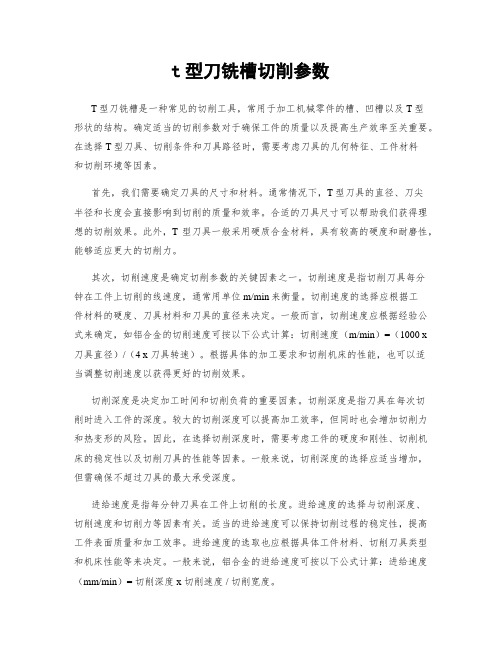
t型刀铣槽切削参数T型刀铣槽是一种常见的切削工具,常用于加工机械零件的槽、凹槽以及T型形状的结构。
确定适当的切削参数对于确保工件的质量以及提高生产效率至关重要。
在选择T型刀具、切削条件和刀具路径时,需要考虑刀具的几何特征、工件材料和切削环境等因素。
首先,我们需要确定刀具的尺寸和材料。
通常情况下,T型刀具的直径、刀尖半径和长度会直接影响到切削的质量和效率。
合适的刀具尺寸可以帮助我们获得理想的切削效果。
此外,T型刀具一般采用硬质合金材料,具有较高的硬度和耐磨性,能够适应更大的切削力。
其次,切削速度是确定切削参数的关键因素之一。
切削速度是指切削刀具每分钟在工件上切削的线速度,通常用单位m/min来衡量。
切削速度的选择应根据工件材料的硬度、刀具材料和刀具的直径来决定。
一般而言,切削速度应根据经验公式来确定,如铝合金的切削速度可按以下公式计算:切削速度(m/min)=(1000 x 刀具直径)/(4 x 刀具转速)。
根据具体的加工要求和切削机床的性能,也可以适当调整切削速度以获得更好的切削效果。
切削深度是决定加工时间和切削负荷的重要因素。
切削深度是指刀具在每次切削时进入工件的深度。
较大的切削深度可以提高加工效率,但同时也会增加切削力和热变形的风险。
因此,在选择切削深度时,需要考虑工件的硬度和刚性、切削机床的稳定性以及切削刀具的性能等因素。
一般来说,切削深度的选择应适当增加,但需确保不超过刀具的最大承受深度。
进给速度是指每分钟刀具在工件上切削的长度。
进给速度的选择与切削深度、切削速度和切削力等因素有关。
适当的进给速度可以保持切削过程的稳定性,提高工件表面质量和加工效率。
进给速度的选取也应根据具体工件材料、切削刀具类型和机床性能等来决定。
一般来说,铝合金的进给速度可按以下公式计算:进给速度(mm/min)= 切削深度 x 切削速度 / 切削宽度。
切削宽度是指切削过程中刀具压入工件的宽度。
切削宽度的选择应考虑工件材料的硬度、切削力的限制和刀具的特性。
UG编程技巧如何优化CNC加工中的快速进给率

UG编程技巧如何优化CNC加工中的快速进给率在现代制造业中,CNC机床已经成为了主要的加工设备。
作为一种自动化程度高、准确度高的加工方式,CNC加工在提高生产效率和产品质量方面发挥着重要作用。
快速进给率是CNC加工中一个关键的参数,优化快速进给率能够进一步提高加工效率和降低生产成本。
本文将探讨UG编程中的技巧,以优化CNC加工中的快速进给率。
1. 合理选择切削工具在进行CNC加工前,需要根据待加工的工件材料和加工要求选择合适的切削工具。
合理选择切削工具能够提高加工效率和延长工具寿命,从而优化快速进给率。
UG编程中,可以通过设置合适的刀具类型、直径、切削刃数和切削速度等参数,来确保切削过程的顺利进行。
2. 优化切削路径在UG编程中,切削路径的规划对快速进给率的优化有着重要的影响。
合理规划切削路径可以减少CNC机床在空转状态下的时间,提高加工效率。
通常,可以采用以下几种方式来优化切削路径:a. 最佳切削方向:根据待加工工件的形状和切削操作的需求,选择最佳的切削方向。
合理的切削方向能够降低切削力和切削温度,从而提高切削效率。
b. 最短路径规划:通过合理排布加工轮廓和利用切削工具的特性,优化切削路径,寻找最短的切削路径,从而减少机床在空转状态下的时间。
c. 防止冗余移动:避免在切削路径中出现冗余移动,减少机床的运动次数,提高加工效率。
3. 合理调整进给速度进给速度直接影响加工效率和表面质量,合理地调整进给速度可以优化快速进给率。
在UG编程中,可以通过调整进给速度来控制切削过程中的进给量,从而提高加工效率。
根据不同的加工工艺和切削条件,可以采用以下几种方式来优化进给速度:a. 提高粗加工速度:对于粗加工环节,可以适度提高进给速度,加快切削过程,提高生产效率。
b. 降低精加工速度:对于精加工环节,为了保证加工质量,可以适度降低进给速度和切削深度,减少切削力和热变形,提高表面质量。
c. 调整进给速度曲线:根据加工工艺和切削条件的要求,在UG编程中可以通过调整进给速度曲线,来实现在不同阶段的快速进给率优化。
- 1、下载文档前请自行甄别文档内容的完整性,平台不提供额外的编辑、内容补充、找答案等附加服务。
- 2、"仅部分预览"的文档,不可在线预览部分如存在完整性等问题,可反馈申请退款(可完整预览的文档不适用该条件!)。
- 3、如文档侵犯您的权益,请联系客服反馈,我们会尽快为您处理(人工客服工作时间:9:00-18:30)。
Selection of optimum tool geometry and cutting conditionsusing a surface roughness prediction model for end milling Abstract Influence of tool geometry on the quality of surface produced is well known and hence any attempt to assess the performance of end milling should include the tool geometry. In the present work, experimental studies have been conducted to see the effect of tool geometry (radial rake angle and nose radius) and cutting conditions (cutting speed and feed rate) on the machining performance during end milling of medium carbon steel. The first and second order mathematical models, in terms of machining parameters, were developed for surface roughness prediction using response surface methodology (RSM) on the basis of experimental results. The model selected for optimization has been validated with the Chi square test. The significance of these parameters on surface roughness has been established with analysis of variance. An attempt has also been made to optimize the surface roughness prediction model using genetic algorithms (GA). The GA program gives minimum values of surface roughness and their respective optimal conditions.1 IntroductionEnd milling is one of the most commonly used metal removal operations in industry because of its ability to remove material faster giving reasonably good surface quality. It is used in a variety of manufacturing industries including aerospace and automotive sectors, where quality is an important factor in the production of slots, pockets, precision moulds and dies. Greater attention is given to dimensional accuracy and surface roughness of products by the industry these days. Moreover, surface finish influences mechanical properties such as fatigue behaviour, wear, corrosion, lubrication and electrical conductivity. Thus, measuring and characterizing surface finish can be considered for predicting machining performance.Surface finish resulting from turning operations has traditionally received considerable research attention, where as that of machining processes using multipoint cutters, requires attention by researchers. As these processes involve large number of parameters, it would be difficult to correlate surface finish with other parameters just by conducting experiments. Modelling helps to understand this kind of process better. Though some amount of work has been carried out to develop surface finish prediction models in the past, the effect of tool geometry has received little attention. However, the radial rake angle has a major affect on the power consumption apart from tangential and radial forces. It also influences chip curling and modifies chip flow direction. In addition to this, researchers [1] have also observed that the nose radius plays a significant role in affecting the surface finish. Therefore the development of agood model should involve the radial rake angle and nose radius along with other relevant factors.Establishment of efficient machining parameters has been a problem that has confronted manufacturing industries for nearly a century, and is still the subject of many studies. Obtaining optimum machining parameters is of great concern in manufacturing industries, where the economy of machining operation plays a key role in the competitive market. In material removal processes, an improper selection of cutting conditions cause surfaces with high roughness and dimensional errors, and it is even possible that dynamic phenomena due to auto excited vibrations may set in [2]. In view of the significant role that the milling operation plays in today‟s manufacturing world, there is a need to optimize the machining parameters for this operation. So, an effort has been made in this paper to see the influence of tool geometry(radial rake angle and nose radius) and cutting conditions(cutting speed and feed rate) on the surface finish produced during end milling of medium carbon steel. The experimental results of this work will be used to relate cutting speed, feed rate, radial rake angle and nose radius with the machining response i.e. surface roughness by modelling. The mathematical models thus developed are further utilized to find the optimum process parameters using genetic algorithms.2 ReviewProcess modelling and optimization are two important issues in manufacturing. The manufacturing processes are characterized by a multiplicity of dynamically interacting process variables. Surface finish has been an important factor of machining in predicting performance of any machining operation. In order to develop and optimize a surface roughness model, it is essential to understand the current status of work in this area.Davis et al. [3] have investigated the cutting performance of five end mills having various helix angles. Cutting tests were performed on aluminium alloy L 65 for three milling processes (face, slot and side), in which cutting force, surface roughness and concavity of a machined plane surface were measured. The central composite design was used to decide on the number of experiments to be conducted. The cutting performance of the end mills was assessed using variance analysis. The affects of spindle speed, depth of cut and feed rate on the cutting force and surface roughness were studied. The investigation showed that end mills with left hand helix angles are generally less cost effective than those with right hand helix angles. There is no significant difference between up milling and down milling with regard tothe cutting force, although the difference between them regarding the surface roughness was large. Bayoumi et al.[4] have studied the affect of the tool rotation angle, feed rate and cutting speed on the mechanistic process parameters (pressure, friction parameter) for end milling operation withthree commercially available workpiece materials, 11 L 17 free machining steel, 62- 35-3 free machining brass and 2024 aluminium using a single fluted HSS milling cutter. It has been found that pressure and friction act on the chip – tool interface decrease with the increase of feed rate and with the decrease of the flow angle, while the cutting speed has a negligible effect on some of the material dependent parameters. Process parameters are summarized into empirical equations as functions of feed rate and tool rotation angle for each work material. However, researchers have not taken into account the effects of cutting conditions and tool geometry simultaneously; besides these studies have not considered the optimization of the cutting process.As end milling is a process which involves a large number f parameters, combined influence of the significant parameters an only be obtained by modelling. Mansour and Abdallaet al. [5] have developed a surface roughness model for the end milling of EN32M (a semi-free cutting carbon case hardening steel with improved merchantability). The mathematical model has been developed in terms of cutting speed, feed rate and axial depth of cut. The affect of these parameters on the surface roughness has been carried out using response surface methodology (RSM). A first order equation covering the speed range of 30–35 m/min and a second order equation covering the speed range of 24–38 m/min were developed under dry machining conditions. Alauddin et al. [6] developed a surface roughness model using RSM for the end milling of 190 BHN steel. First and second order models were constructed along with contour graphs for the selection of the proper combination of cutting speed and feed to increase the metal removal rate without sacrificing surface quality. Hasmi et al. [7] also used the RSM model for assessing the influence of the workpiece material on the surface roughness of the machined surfaces. The model was developed for milling operation by conducting experiments on steel specimens. The expression shows, the relationship between the surface roughness and the various parameters; namely, the cutting speed, feed and depth of cut. The above models have not considered the affect of tool geometry on surface roughness.Since the turn of the century quite a large number of attempts have been made to find optimum values of machining parameters. Uses of many methods have been reported in the literature to solve optimization problems for machining parameters. Jain and Jain [8] have used neural networks for modeling and optimizing the machining conditions. The results have been validated by comparing the optimized machining conditions obtained using genetic algorithms. Suresh et al. [9] have developed a surface roughness prediction model for turning mild steel using a response surface methodology to produce the factor affects of the individual process parameters. They have also optimized the turning process using the surface roughness prediction model as the objective function. Considering the above, an attempt has been made in this work to develop a surface roughness model with tool geometry and cutting conditions on the basis ofexperimental results and then optimize it for the selection of these parameters within the given constraints in the end milling operation.3 MethodologyIn this work, mathematical models have been developed using experimental results with the help of response surface methodolog y. The purpose of developing mathematical models relating the machining responses and their factors is to facilitate the optimization of the machining process. This mathematical model has been used as an objective function and the optimization was carried out with the help of genetic algorithms.3.1 Mathematical formulationResponse surface methodology(RSM) is a combination of mathematical and statistical techniques useful for modelling and analyzing the problems in which several independent variables influence a dependent variable or response. The mathematical models commonly used are represented by:where Y is the machining response, ϕ is the response function and S, f , α, r are milling variables and ∈is the error which is normally distributed about the observed response Y with zero mean.The relationship between surface roughness and other independent variables can be represented as follows,where C is a constant and a, b, c and d are exponents.To facilitate the determination of constants and exponents, this mathematical model will have to be linearized by performing a logarithmic transformation as follows:The constants and exponents C, a, b, c and d can be determined by the method of least squares. The first order linear model, developed from the above functional relationship using least squares method, can be represented as follows:where Y1 is the estimated response based on the first-order equation, Y is the measured surface roughness on a logarithmic scale, x0 = 1 (dummy variable), x1, x2, x3 and x4 are logarithmic transformations of cutting speed, feed rate, radial rake angle and nose radius respectively, ∈is the experimental error and b values are the estimates of corresponding parameters.The general second order polynomial response is as given below:where Y2 is the estimated response based on the second order equation. The parameters, i.e. b0, b1, b2, b3, b4, b12, b23, b14, etc. are to be estimated by the method of least squares. Validity of the selected model used for optimizing the process parameters has been tested with the help of statistical tests, such as F-test, chi square test, etc. [10].3.2 Optimization using genetic algorithmsMost of the researchers have used traditional optimization techniques for solving machining problems. The traditional methods of optimization and search do not fare well over a broad spectrum of problem domains. Traditional techniques are not efficient when the practical search space is too large. These algorithms are not robust. They are inclined to obtain a local optimal solution. Numerous constraints and number of passes make the machining optimization problem more complicated. So, it was decided to employ genetic algorithms as an optimization technique. GA come under the class of non-traditional search and optimization techniques. GA are different from traditional optimization techniques in the following ways:1.GA work with a coding of the parameter set, not the parameter themselves.2.GA search from a population of points and not a single point.3.GA use information of fitness function, not derivatives or other auxiliary knowledge.4.GA use probabilistic transition rules not deterministic rules.5.It is very likely that the expected GA solution will be the global solution.Genetic algorithms (GA) form a class of adaptive heuristics based on principles derived from the dynamics of natural population genetics. The searching process simulates the natural evaluation of biological creatures and turns out to be an intelligent exploitation of a random search. The mechanics of a GA is simple, involving copying of binary strings. Simplicity of operation and computational efficiency are the two main attractions of the genetic algorithmic approach. The computations are carried out in three stages to get a result in one generation or iteration. The three stages are reproduction, crossover and mutation.In order to use GA to solve any problem, the variable is typically encoded into a string (binary coding) or chromosome structure which represents a possible solution to the given problem. GA begin with a population of strings (individuals) created at random. The fitness of each individual string is evaluated with respect to the given objective function. Then this initial population is operated on by three main operators – reproduction cross over and mutation– to create, hopefully, a better population. Highly fit individuals or solutions are given the opportunity to reproduce by exchanging pieces of their genetic information, in the crossover procedure, with other highly fit individuals. This produces new “offspring” solutions, which share some characteristics taken from both the parents. Mutation is often applied after crossover by altering some genes (i.e. bits) in the offspring. The offspring can either replace the whole population (generational approach) or replace less fit individuals (steady state approach). This new population is further evaluated and tested for some termination criteria. The reproduction-cross over mutation- evaluation cycle is repeated until the termination criteria aremet.4 Experimental detailsFor developing models on the basis of experimental data, careful planning of experimentation is essential. The factors considered for experimentation and analysis were cutting speed, feed rate, radial rake angle and nose radius.4.1 Experimental designThe design of experimentation has a major affect on the number of experiments needed. Therefore it is essential to have a well designed set of experiments. The range of values of each factor was set at three different levels, namely low, medium and high as shown in Table 1. Based on this, a total number of 81 experiments (full factorial design), each having a combination of different levels of factors, as shown in Table 2, were carried out.The variables were coded by taking into account the capacity and limiting cutting conditions of the milling machine. The coded values of variables, to be used in Eqs. 3 and 4, were obtained from the following transforming equations:where x1 is the coded value of cutting speed (S), x2 is the coded value of the feed rate ( f ), x3 is the coded value of radial rake angle(α) and x4 is the coded value of nose radius (r).4.2 ExperimentationA high precision …Rambaudi Rammatic 500‟ CNC milling machine, with a vertical milling head, was used for experimentation. The control system is a CNC FIDIA-12 compact. The cutting tools, used for the experimentation, were solid coated carbide end mill cutters of different radial rake angles and nose radii (WIDIA: DIA20 X FL38 X OAL 102 MM). The tools are coated with TiAlN coating. The hardness, density and transverse rupture strength are 1570 HV 30, 14.5 gm/cm3 and 3800 N/mm2 respectively.AISI 1045 steel specimens of 100×75 mm and 20 mm thickness were used in the present study. All the specimens were annealed, by holding them at 850 ◦C for one hour and then cooling them in a furnace. The chemical analysis of specimens is presented in Table 3. The hardness of the workpiece material is 170 BHN. All the experiments were carried out at a constant axial depth of cut of 20 mm and a radial depth of cut of 1 mm. The surface roughness (response) was measured with Talysurf-6 at a 0.8 mm cut-off value. An average of four measurements was used as a response value.5 Results and discussionThe influences of cutting speed, feed rate, radial rake angle and nose radius have been assessed by conducting experiments. The variation of machining response with respect to the variables was shown graphically in Fig. 1. It is seen from these figures that of the four dependent parameters, radial rake angle has definite influence on the roughness of the surface machined using an end mill cutter. It is felt that the prominent influence of radial rake angle on the surface generation could be due to the fact that any change in the radial rake angle changes the sharpness of the cutting edge on the periphery, i.e changes the contact length between the chip and workpiece surface. Also it is evident from the plots that as the radial rake angle changes from 4◦to 16◦, the surface roughness decreases and then increases. Therefore, it may be concluded here that the radial rake angle in the range of 4◦to 10◦would give a better surface finish. Figure 1 also shows that the surface roughness decreases first and then increases with the increase in the nose radius. This shows that there is a scope for finding the optimum value of the radial rake angle and nose radius for obtaining the best possible quality of the surface. It was also found that the surface roughness decreases with an increase in cutting speed and increases as feed rate increases. It could also be observed that the surface roughness was a minimum at the 250 m/min speed, 200 mm/min feed rate, 10◦radial rake angle and 0.8 mm nose radius. In order to understand the process better, the experimental results can be used to develop mathematical models using RSM. In this work, a commercially available mathematical software package (MATLAB) was used for the computation of the regression of constants and exponents.5.1 The roughness modelUsing experimental results, empirical equations have been obtained to estimate surface roughness with the significant parameters considered for the experimentation i.e. cutting speed, feed rate, radial rake angle and nose radius. The first order model obtained from the above functional relationship using the RSM method is as follows:The transformed equation of surface roughness prediction is as follows:Equation 10 is derived from Eq. 9 by substituting the coded values of x1, x2, x3 and x4 in terms of ln s, ln f , lnαand ln r. The analysis of the variance (ANOV A) and the F-ratio test have been performed to justify the accuracy of the fit for the mathematical model. Since the calculated values of the F-ratio are less than the standard values of the F-ratio for surface roughness as shown in Table 4, the model is adequate at 99% confidence level to represent the relationship between the machining response and the considered machining parameters of the end milling process.The multiple regression coefficient of the first order model was found to be 0.5839. Thisshows that the first order model can explain the variation in surface roughness to the extent of 58.39%. As the first order model has low predictability, the second order model has been developed to see whether it can represent better or not.The second order surface roughness model thus developed is as given below:where Y2 is the estimated response of the surface roughness on a logarithmic scale, x1, x2, x3 and x4 are the logarithmic transformation of speed, feed, radial rake angle and nose radius. The data of analysis of variance for the second order surface roughness model is shown in Table 5.Since F cal is greater than F0.01, there is a definite relationship between the response variable and independent variable at 99% confidence level. The multiple regression coefficient of the second order model was found to be 0.9596. On the basis of the multiple regression coefficient (R2), it can be concluded that the second order model was adequate to represent this process. Hence the second order model was considered as an objective function for optimization using genetic algorithms. This second order model was also validated using the chi square test. The calculated chi square value of the model was 0.1493 and them tabulated value at χ2 0.005 is 52.34, as shown in Table 6, which indicates that 99.5% of the variability in surface roughness was explained by this model.Using the second order model, the surface roughness of the components produced by end milling can be estimated with reasonable accuracy. This model would be optimized using genetic algorithms (GA).5.2 The optimization of end millingOptimization of machining parameters not only increases the utility for machining economics, but also the product quality toa great extent. In this context an effort has been made to estimate the optimum tool geometry and machining conditions to produce the best possible surface quality within the constraints.The constrained optimization problem is stated as follows: Minimize Ra using the model given here:where xil and xiu are the upper and lower bounds of process variables xi and x1, x2, x3, x4 are logarithmic transformation of cutting speed, feed, radial rake angle and nose radius.The GA code was developed using MATLAB. This approach makes a binary coding system to represent the variables cutting speed (S), feed rate ( f ), radial rake angle (α) and nose radius (r), i.e. each of these variables is represented by a ten bit binary equivalent, limiting the totalstring length to 40. It is known as a chromosome. The variables are represented as genes (substrings) in the chromosome. The randomly generated 20 such chromosomes (population size is 20), fulfilling the constraints on the variables, are taken in each generation. The first generation is called the initial population. Once the coding of the variables has been done, then the actual decoded values for the variables are estimated using the following formula: where xi is the actual decoded value of the cutting speed, feed rate, radial rake angle and nose radius, x(L) i is the lower limit and x(U) i is the upper limit and li is the substring length, which is equal to ten in this case.Using the present generation of 20 chromosomes, fitness values are calculated by the following transformation:where f(x) is the fitness function and Ra is the objective function.Out of these 20 fitness values, four are chosen using the roulette-wheel selection scheme. The chromosomes corresponding to these four fitness values are taken as parents. Then the crossover and mutation reproduction methods are applied to generate 20 new chromosomes for the next generation. This processof generating the new population from the old population is called one generation. Many such generations are run till the maximum number of generations is met or the average of four selected fitness values in each generation becomes steady. This ensures that the optimization of all the variables (cutting speed, feed rate, radial rake angle and nose radius) is carried out simultaneously. The final statistics are displayed at the end of all iterations. In order to optimize the present problem using GA, the following parameters have been selected to obtain the best possible solution with the least computational effort: Table 7 shows some of the minimum values of the surface roughness predicted by the GA program with respect to input machining ranges, and Table 8 shows the optimum machining conditions for the corresponding minimum values of the surface roughness shown in Table 7. The MRR given in Table 8 was calculated bywhere f is the table feed (mm/min), aa is the axial depth of cut (20 mm) and ar is the radial depth of cut (1 mm).It can be concluded from the optimization results of the GA program that it is possible to select a combination of cutting speed, feed rate, radial rake angle and nose radius for achieving the best possible surface finish giving a reasonably good material removal rate. This GA program provides optimum machining conditions for the corresponding given minimum values of the surface roughness. The application of the genetic algorithmic approach to obtain optimal machining conditions will be quite useful at the computer aided process planning (CAPP) stage in the production of high quality goods with tight tolerances by a variety of machining operations, and in the adaptive control of automated machine tools. With the known boundaries of surfaceroughness and machining conditions, machining could be performed with a relatively high rate of success with the selected machining conditions.6 ConclusionsThe investigations of this study indicate that the parameters cutting speed, feed, radial rake angle and nose radius are the primary actors influencing the surface roughness of medium carbon steel uring end milling. The approach presented in this paper provides n impetus to develop analytical models, based on experimental results for obtaining a surface roughness model using the response surface methodology. By incorporating the cutter geometry in the model, the validity of the model has been enhanced. The optimization of this model using genetic algorithms has resulted in a fairly useful method of obtaining machining parameters in order to obtain the best possible surface quality.。
